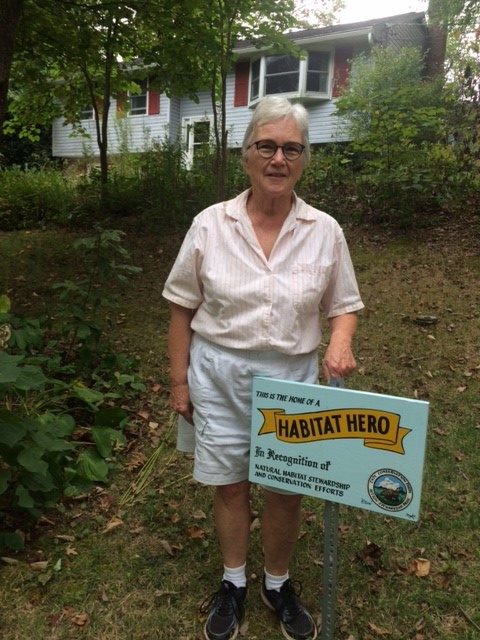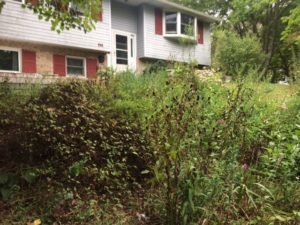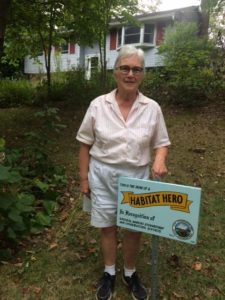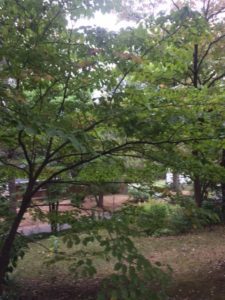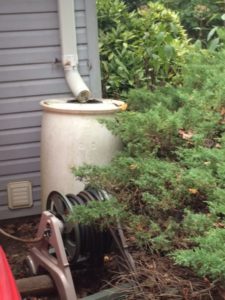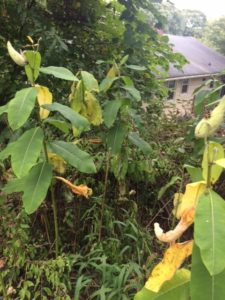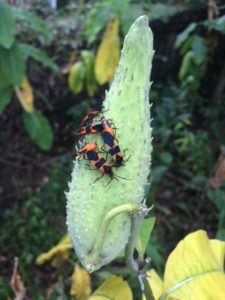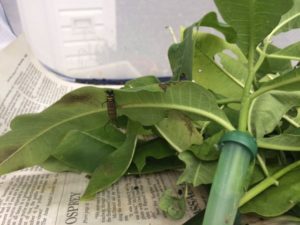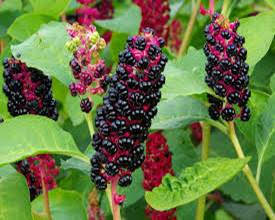
The Serene Ravine of Lake Claire
September 11, 2019Keeping the Fall Chores Away
October 9, 2019Virginia Klocko
Ever since Bill and Virginia Klocko moved into their house in Cape St Claire, Virginia has been hard at work removing non-native and invasive plants from the property. It started with Crown vetch that was creeping its way under the cement steps and driveway and continues today with English ivy. Virginia is a Master Gardener with a passion for Monarch butterflies that she raises from caterpillar to chrysalis before releasing the butterflies (34 total so far this year with 50 more in various stages of chrysalis and caterpillars). Virginia has 5 separate composting bins for yard waste, newspapers and scraps that she uses to enhance her landscape. She saves waste water from the washing machine and dishwashing to water her plants. Instead of an electric dryer she hangs her clothes on a line to air dry saving electricity! The Klockos are practicing many environmentally conscious habits that make them Habitat Heroes and good stewards of their land. In addition to our reward Virginia’s yard has been Baywise Certified by the Master Gardeners, meaning they are practicing bay safe habitats for clean water.
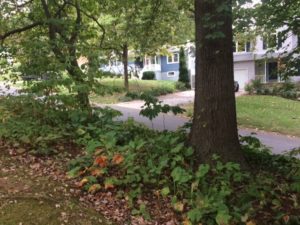
The first thing Virginia showed me was her Monarch nursery. She has several enclosed mesh baskets where she is raising monarch caterpillars. She collects them from her Asclepias syriaca common milkweed around her yard, adds cut Milkweed to the cage and protects them from predators. They form their chrysalis and attach themselves to the top of the mesh enclosure. Once they emerge as the beautiful Monarch butterflies she releases them back into the wild. Fortunately for them her yard has an abundance of native plants offering nectar for them.
I was so excited walking around her yard as she pointed out all the native plants she had growing there. Many she has planted but just as many have volunteered in her yard. There are multiple levels to the yard as the house sits on top a hill. As we weaved our way through I could see and hear a group of birds enjoying the habitat provided for them. At one point we had to switch directions and go around a gorgeous spider web that had made its home among the meadow like front yard, no doubt a prime location for catching his dinner. I was delighted too by the plants that were blooming for the fall that would benefit migrating birds and butterflies: they included White wood aster, various Aster species, Mountain mint, Virginia creeper, and Blue mist flowers. There are numerous trees and shrubs providing berries such as American holly, Viburnum, Dogwood, and Black cherry. The seed heads of the River oats are beginning to put on their amazing autumn show! The NY Ironweed and Joe-Pye weed is waning but their fluffy seed heads are calling out to the birds to feast upon.
I cannot wait to go back and visit this oasis next spring or early summer to witness the Baptisia, Blue bells, Milkweed, Black eyed Susans, Brown eyed Susans, Carolina Allspice bush, Redbud tree, Itea, Penstemon, Amsonia, and Elderberry all bursting with their beautiful colors and providing nectar sources, nesting places and protection from predators.
The yard is covered in groundcovers that control erosion and are a great alternative to a typical lawn that is devoid of life. There is Sedum ternatum, Wild ginger, Solomon’s seal, Christmas ferns, Partridge berry, and a lush mossy area. Many of these sprouted in her yard and have woven themselves into the landscaped quite comfortably, like an old friend.
The list of native trees in this quarter acre Cape lot is impressive. Again, many sprung up on their own or are the babies of the more mature trees. The list of trees, understory trees and shrubs includes Holly, Redbuds, Pawpaw, Dogwood, Beech, White oak (the largest host plant for butterflies), Sassafras, Blueberry (high and low bush), and Viburnums. Not only do they provide shelter and nesting spots for the birds and small mammals but many host many species of caterpillars that become moths and caterpillars. Those caterpillars are what the nesting birds feed their young. The whole food web is playing out in their very own backyard making the Klockos an excellent choice for our newest Habitat Hero of 2019.
They will be on our Habitat Hero Tour next June so you can see all the amazing ecosystem support they are providing to the local flora and fauna of Cape St Claire. Email me with any questions or to nominate yourself or neighbor as our next Habitat Hero. [email protected]


